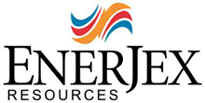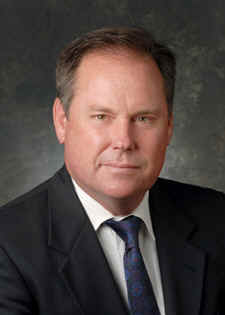CEOCFO-Members Login
Become A Member!
EnerJex Resources, Inc.
(EJXR-OTC: BB)
Print Version

|
This is a printer friendly page!
EnerJex
Resources Is Bringing The Capital, The Technology And The Expertise Necessary To Acquire
And Bring Fully Into Operation Producing Oil And Gas Properties In Eastern Kansas, And To
Extract Additional Upside Over And Above The Traditional Production Rates Of These
Properties

Basic Materials
Oil & Gas Drilling & Exploration
(EJXR-OTC: BB)
EnerJex Resources, Inc.
7300 West 110th, 7th Floor
Overland Park, KS 66210
Phone: 913-693-4600

Steve Cochennet
Chairman, President and CEO
Interview conducted by:
Lynn Fosse, Senior Editor
CEOCFOinterviews.com
Published –
October 26, 2007
BIO:
Steve Cochennet is the President, CEO, Chairman,
Secretary and Treasurer of EnerJex. Prior to helping form EnerJex in 2005, Mr.
Cochennet was the President of CSC Group, a strategic consulting group working with
Fortune 500 Companies as well as emerging and start-up companies in a variety of
capacities including facilitating capital formation. Prior to founding CSC Group in 2002,
Mr. Cochennet spent 16 years with Aquila. At Aquila, Mr. Cochennet rose from Manager of
Finance in Aquila's predecessor corporation, UtiliCorp United, to President of Aquila's
Strategic Partners Group in 2000, where he was responsible for managing senior
relationships with key national energy executives and coordinating business opportunities
across Aquila's 15 business units. Prior to joining UtiliCorp, Mr. Cochennet spent five
years with the Federal Reserve Bank of Kansas City, where he was a commissioned examiner
for the 10th district of the Federal Reserve System.
Company Profile:
EnerJex Resources, Inc. (EnerJex) is an oil and natural gas acquisition and
development company. Operations are currently focused on the Mid-Continent region of the
United States and – more specifically – eastern Kansas.
EnerJex acquires oil
and natural gas mineral leases that have existing production and cash flow. Once acquired,
EnerJex implements an accelerated development program utilizing capital, a regional
operating focus, and new technology to enhance cash flow and return on investment.
CEOCFO: Mr. Cochennet, what was
your vision when you formed the company and where are you today?
Mr. Cochennet: “The vision of the company was to
aggregate small oil and gas properties in eastern Kansas. Kansas production is extremely
fragmented with over 23,000 individual producers. This structure prohibits current owners
from efficiently attracting large capital blocks to fully develop their properties. Thus,
the properties can be acquired at very attractive prices and rolled up into a larger
aggregated oil and gas production company at significantly lower costs than what other
companies are paying for energy properties.”
CEOCFO: Where are you in the
process?
Mr. Cochennet: “We completed a $9 million
financing in April of this year. We are publicly traded on the bulletin board since April
of this year under the symbol EJXR. We have allocated half of that capital at this point.
We just completed our August operational update and we have gone from basically zero
production to 115 to 120 barrels a day of oil and gas equivalent. We are looking at a
couple more acquisitions that we hope to close in the next thirty days. By year-end, we
will have all of the capital allocated from this financing and should be cash flow
positive. We will be looking to do our second round capital raise probably in the second
quarter of 2008.”
CEOCFO: How did you recognize
the opportunity and why is this an area that hasn’t been taken advantage of; what do
you see that others did not?
Mr. Cochennet: “As of a couple years ago, the
state of Kansas was the fifth largest oil producer in the country, yet there are 23,000
independent producers of which 5,000 account for 30% of the production. It is a very
fragmented business and in the instance of this part of the country, you had folks who
have 500 to 10,000 acres, and have only drilled a few wells. Therefore, it is primarily
the local landowners who have made money over the years. Most of these landowners do not
have the capital, have not been keeping up to date on technology and do not have what we
consider operational expertise, therefore, most of these properties just sit there. What
EnerJex brings to the table is our ability, now that we are a publicly traded company, to
attract capital to fund the drilling operations. We also bring operational expertise and
the ability to apply new technology to locate and drill for oil. In addition, we can buy
these properties at relatively inexpensive prices because we are buying them at 25 or 50
barrels a day. It is small production, where the majors would not be interested at this
point; it just makes a combination of facts, like a perfect storm. This scenario allows us
to aggregate properties at fairly low cost.”
CEOCFO: Please tell us about
the newer technologies that you are able to implement today?
Mr. Cochennet: “They are not necessarily new in
the oil and gas industry per se, but they are new to eastern Kansas. They are horizontal
drilling, coil tubing, gas fractionation, and even 3-D seismic to a certain extent. In
this part of the country, these technologies have not been used for shallow oil and gas
production. There are also some new chemical processes out there that EnerJex is using
that will enhance production. We consider all of these things when we are evaluating the
properties we are acquiring and believe that we will be able to extract additional upside
over and above the traditional production rates of these properties.”
CEOCFO: Will you be drilling in
new areas? What is the plan going forward?
Mr. Cochennet: “Right now, the properties that we
have acquired and are considering currently have active production. Our view is that we
would like to acquire properties that already have production, that have operational
upside and production upside, and that have not been recognized to-date. When we buy a
property that is producing 30 barrels a day, by employing some operational upgrades and
additional capital, we may be able to double that production within a relatively short
time frame. Plus, each property typically has considerable additional drillables. This
would not be considered ‘wildcatting’; this is infield drilling and we are
stepping up the current production and increasing value over and above what the property
is currently producing by bringing efficiencies to market. We are not going to take
fifty-thousand acres that have not been drilled; we are buying something that has been
producing for a long time, and that has other production around it. We might buy a
property that doesn’t have any wells, but it would have drillables on it and be
surrounded by properties that do have producing wells. What we do is probably at the lower
end of the risk spectrum in terms of development. It is more tried and true method.
Simply, we attract capital, buy at the right price and then bring our expertise to enhance
and improve the production on those properties.”
CEOCFO: Are your properties all
100% owned, and do you see partnerships or joint ventures in the future?
Mr. Cochennet: “Currently, all but one of our
properties are 100% working interest. We have one property where we have brought in a
group from Europe, Euramerica Energy Inc. They have contributed $526,000 to basically
develop one of our gas properties. They have the right to purchase that property for what
we have invested in it, which is approximately $1.2 million. If purchased, we will
continue to operate it. We will drill 10 wells and complete three of them. They have until
March 1st of 2008 to decide whether they want the property. Once they receive
their investment back in profits from the production, EnerJex will have a 25% working
interest. All of the other properties we have either acquired or looking to acquire, we
will own and operate 100% at least initially.”
CEOCFO: Are people coming to
you now and saying, ‘take my well’?
Mr. Cochennet: “There have been two or three
articles in the local papers, so we are starting to get the word out and we are starting
to get more and more calls. It is a matter of having the capital available to acquire
them, but we will continue to evaluate all of them and be ready to act once we have raised
additional capital. The capital we raised in April will be deployed by the end of this
year, so until we do a secondary raise, we will be limited.”
CEOCFO: You have plenty to keep
you busy!
Mr. Cochennet: “We will probably have drilled up
to 100 new wells by the end of the year – so we are keeping quite busy.”
CEOCFO: Are you finding it
difficult to find the people and equipment you need?
Mr. Cochennet: “No, actually not. Our Black Oaks
operating partner, Mark Haas as been a tremendous resource. Mark has been an operator for
about 30 years. His family is third or fourth generation, and has been drilling in Kansas
since the 1920’s. When it comes to drilling equipment and pumping, operations, they
have been doing it for a very long time and are very well respected in the region. His
business has been through the highs and lows of oil prices – they are very astute and
efficient. With Mark, not only did we have an agreement to develop a couple of his
properties; he has an additional property that – as we get capital -\we will probably
fold into the company over time. At this point, he is an outside consultant that not only
manages the Black Oaks project, but also provides support in terms of material, personnel,
and equipment, whether it be pulling, drilling or whatever. He has been instrumental in
our ability to grow.”
CEOCFO: Other than raising
capital are there any challenges you need to be on the lookout for?
Mr. Cochennet: “I would say our biggest challenge
— if we continue to grow exponentially -- will we continuing to hire people in the
field to match our growth. With all of the fluctuation over the last 10 to 29 years in the
oil business, many people left the industry. We will need to find pumpers, pullers, and
personnel and start training people now to be able to fill the operational needs
we’ll have as we continue to grow. To me that is going to be the biggest
challenge.”
CEOCFO: In closing, please tell
potential investors why EnerJex should stand out from the crowd.
Mr. Cochennet: “EnerJex has a relatively low-risk,
fundamental strategy; we buy properties that have a pay-back within a relatively short
period of time and there is upside in terms of development and efficiency. As we continue
to execute our plan, it will become profitable. We also minimize the risk by hedging 50 to
70 percent of our production as it comes in the door, so we are not going to take
commodity risks. Again, if we can make a 30 or 40 percent ROI (return on investment) on a
property, we are going to make money. If you are looking for something that is going to
sell at a fifty multiple, this is probably not going to be your company. If you want a
company that has developed a track record, and that will continue to grow and be
profitable, then we are probably a great choice. We are going to be profitable, grow our
earnings, and stick to our game plan.”
disclaimers
Any reproduction or further distribution of this
article without the express written consent of CEOCFOinterviews.com is prohibited.
|



